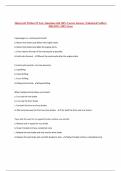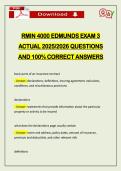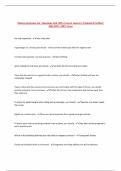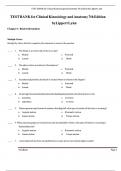TEST BANK
Pediatric Nursing A Case-Based Approach
1st Edition
9781496394224 Stuvia.com - The Marketplace to Buy and Sell your Study Material
Table of Contents
Chapter 01 Chip Jones: Bronchiolitis 1
Chapter 02 Mollie Sanders: Asthma 11
Chapter 03 David Torez: Ulnar Fracture 21
Chapter 04 Ellie Raymore: Urinary Tract Infection and Pyelonephritis 30
Chapter 05 Maalik Abdella: Gastroenteritis, Fever, and Dehydration 40
Chapter 06 Abigail Hanson: Leukemia 52
Chapter 07 Caleb Yoder: Heart Failure 63
Chapter 08 Andrew Hocktochee: Failure to Thrive 73
Chapter 09 Jessica Wang: Tonic-Clonic Seizures 82
Chapter 10 Sophia Carter: Diabetes Mellitus Type 1 92
Chapter 11 Chase McGovern: Second-Degree Burns 102
Chapter 12 Natasha Austin: Sickle Cell Anemia 111
Chapter 13 Jack Wray: Attention Deficit Hyperactivity Disorder 120
Chapter 14 Adelaide Wilson: Obesity 129
Chapter 15 Care of the Newborn and Infant 139
Chapter 16 Care of the Toddler 147
Chapter 17 Care of the Preschooler 155
Chapter 18 Care of the School-Age Child 163
Chapter 19 Care of the Adolescent 171
Chapter 20 Alterations in Respiratory Function 180
Chapter 21 Alterations in Cardiac Function 188
Chapter 22 Alterations in Neurologic and Sensory Function 196
Chapter 23 Alterations in Gastrointestinal Function 204
Chapter 24 Alterations in Genitourinary Function 212
Chapter 25 Alterations in Hematologic Function 220
Chapter 26 Oncological Disorders 228
Chapter 27 Alterations in Musculoskeletal Function 236
Chapter 28 Alterations in Neuromuscular Function 244
Chapter 29 Alterations in Integumentary Function 252
Chapter 30 Alterations in Immune Function 260
Chapter 31 Alterations in Endocrine Function 268
Chapter 32 Genetic Disorders 276
Chapter 33 Alterations in Cognitive and Mental Health 284
Chapter 34 Pediatric Emergencies 293Stuvia.com - The Marketplace to Buy and Sell your Study Material
Downloaded by: Quizmatics |
Distribution of this document is illegalWant to earn $1.236 extra per year? Stuvia.com - The Marketplace to Buy and Sell your Study Material
Chapter 01: Chip Jones: Bronchiolitis 1. A nurse is providing care for a 4-month-old infant at the pediatric clinic. During the assessment the nurse should expect that the infant has reached which developmental milestone(s)? Select all that apply. A. Uses pincer grasp to pick up items B. Can roll over from front onto back C. Pulls self up to a standing position D. Recognizes family members' faces E. Pushes self up on arms from a prone position F. Sits with support ANS: B, D, E, F Rationale: At 4 months of age, an infant is able to roll over from prone to supine position, push the head/chest up on arms from a prone positio n, sit with support and recognize the faces of close family members. The use of the pincer grasp and the ability to pull self up to a standing position are expected at 10 months of age. PTS: 1 REF: p. 4 OBJ: 1 NAT: Client Needs: Health Promotion and Maintenance TOP: Chapter 1: Chip Green: Bronchiolitis BLM: Cognitive Level: Understand 2. A nurse is assessing a 3-month-old infant during a pediatric clinic visit. The nurse believes the infant is demonstrating early manifestations of res piratory distress. Which clinical manifestation(s) should the nurse document? Select all that apply. A. Bradycardia B. Acrocyanosis C. Intercostal retractions D. Nasal congestion E. Tachypnea ANS: D, E Rationale: Early signs of respiratory distress in a n infant include fussiness, nasal congestion, tachypnea and no interest in feeding. Intercostal r etractions are signs of moderate distress; bradycardia can be seen with severe respiratory dis tress. Acrocyanosis, in and of itself, is not a sign of respiratory distress as it can be caused by poor circulation and cold extremities. PTS: 1 REF: p. 8 OBJ: 4 NAT: Client Needs: Physiological Integrity: Physiol ogical Adaptation TOP: Chapter 1: Chip Green: Bronchiolitis BLM: Cognitive Level: Apply 3. A nurse is caring for an infant newly admitted for suspected bronchiolitis. The infant's parent is very upset and states "I am so worried about my infant. What can you do to help my infant?" What is the nurse's best response? A. "There is no need to worry; we care for cases like this all the time." B. "I know this is hard for you but do not worry. We w ill be able to discharge your infant in a few days." C. "No worries; having you hold the infant is very hel pful. The infant will be back at home in no time." D. "I know it is difficult to see your infant like thi s. We will suction your infant and ______________________________________________________________________________________________
______________________________________________________________________________________________Test Bank - Pediatric Nursing: A Case-Based Approach, 1st Edition (Tagher, 2020)
1 | P a g eStuvia.com - The Marketplace to Buy and Sell your Study Material
Downloaded by: Quizmatics |
Distribution of this document is illegalWant to earn $1.236 extra per year? Stuvia.com - The Marketplace to Buy and Sell your Study Material
give oxygen to make the infant comfortable. ANS: D Rationale: The option that states that it is diffic ult to see the infant like this is the only response that explains to the parent what the nurse can do to help the infant and acknowledges the parent's concern. The remaining options recogniz e the parent's concern but do not answer the parent's question. PTS: 1 REF: p. 10 OBJ: 7 NAT: Client Needs: Psychosocial Integrity TOP: Chapter 1: Chip Green: Bronchiolitis BLM: Cognitive Level: Apply 4. A 3-month-old infant is hospitalized with a diagnos is of bronchiolitis. The nurse is creating a plan of care for the infant. Which intervention is a priority ? A. Provide parental teaching on the antibiotics the in fant will need to take at home. B. Administer oxygen to maintain the infant's oxygen s aturation at or above 92%. C. Allow the parents to remain by the infant's side th roughout the hospitalization. D. Keep the infant NPO until the condition has resolve d. ANS: B Rationale: Therapeutic management of bronchiolitis includes the administration of oxygen to maintain O 2 saturation at 92% or higher. Current evidence shows that antibiotics do not improve outcomes in the treatment of bronchiolitis. Infants with bronchiolitis are encouraged to feed as tolerated to maintain nutrition and flui d balance. While it is important for the parents to be allowed to remain at the infant's side , it is not the priority. PTS: 1 REF: p. 14 OBJ: 7 NAT: Client Needs: Physiological Integrity: Physiol ogical Adaptation TOP: Chapter 1: Chip Green: Bronchiolitis BLM: Cognitive Level: Apply 5. ______________________________________________________________________________________________
______________________________________________________________________________________________Test Bank - Pediatric Nursing: A Case-Based Approach, 1st Edition (Tagher, 2020)
2 | P a g eStuvia.com - The Marketplace to Buy and Sell your Study Material
Downloaded by: Quizmatics |
Distribution of this document is illegalWant to earn $1.236 extra per year?





